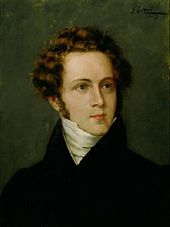Vaga luna, che inargenti

"Vaga luna, che inargenti" (Beautiful moon, dappling with silver) is an arietta composed by Vincenzo Bellini to an anonymous Italian text and dedicated to Giulietta Pezzi.[1] It was published in 1838 by Casa Ricordi in Tre ariette inedite along with two other Bellini songs, "Il fervido desiderio" and "Dolente immagine di Fille mia". It was also amongst the fifteen Bellini songs published by Ricordi under the title Composizioni da Camera in 1935, the centenary of the composer's death. Composed in the bel canto style, it is a frequent recital piece, and has often been recorded. Its original key is in A-flat major with a tempo of andante cantabile.
Lyrics[edit]
Vaga luna, che inargenti |
Beautiful moon, dappling with silver |
Sources[edit]
- ^ Concert notes, 24 April 2008, Istituto Italiano di Cultura di Nairobi
- Paton, John Glenn (2004). Gateway to Italian Songs and Arias: High Voice. Alfred Music Publishing, pp. 130–135. ISBN 0-7390-3547-9
